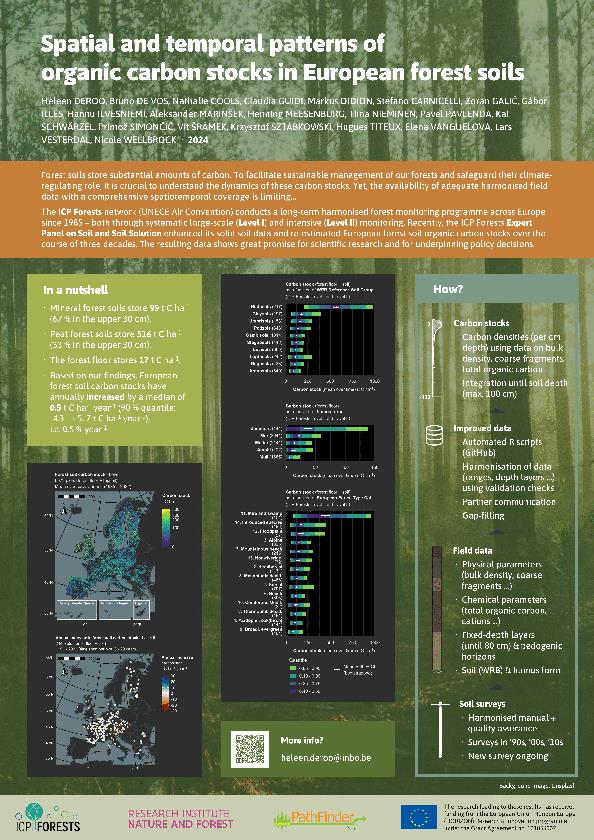Spatial and temporal patterns of organic carbon stocks in European forest soils
Since the early 1990s, the ICP Forests programme runs a long-term harmonised forest soil monitoring survey in managed forests across Europe, including extensive monitoring on a systematic 16 x 16-km grid (Level I: approximately 5000 plots) and intensive monitoring at a roughly 10-year time interval (Level II: approximately 350 plots). This involves the sampling and analysis of a wide range of chemical and physical soil properties - covering pedogenic horizons as well as fixed-depth layers - by national surveyors and laboratories, in accordance with harmonised protocols. All data is stored in the centralised database of the Programme Coordinating Centre of ICP Forests.
Within the ICP Forests Expert Panel on Soil and Soil Solution, we joined forces to validate and fill gaps in these unique three-decade datasets using a newly developed R algorithm. Building upon these enhanced data layers, we used data on total organic carbon, bulk density, coarse fragments and soil depth, to re-estimate European forest soil organic carbon stocks, along with their uncertainties.
In this presentation, we will introduce the latest results of the European forest soil carbon stock evaluation, and present the outcomes of ongoing statistical analyses to reveal spatial patterns and any temporal trends attributable to ongoing environmental changes, stratified by soil type, humus form, forest type and biogeographical region. To ensure the provision of forest ecosystem services in the face of climate change, our forthcoming dataset will be invaluable in underpinning forest management decisions.
Details
| Aantal pagina's | 1 |
|---|---|
| Type | Poster |
| Categorie | Onderzoek |
| Taal | Engels |
Bibtex
@misc{bfeaef45-43c9-4eaa-9855-dc2a87e0e76a,
title = "Spatial and temporal patterns of organic carbon stocks in European forest soils",
abstract = "Forest soils are known for their ability to store substantial amounts of organic carbon as a result of high biomass inputs and relatively slow decomposition rates. Since carbon largely controls physical, chemical and biological processes, forest soils play a key role in providing a wide range of ecosystem services at various scales. Insight into the response of forest soil organic carbon stocks to ongoing environmental changes at the European level, however, is essential for sustainable forest management, but relies on the availability of harmonised, spatially and temporally representative data.
Since the early 1990s, the ICP Forests programme runs a long-term harmonised forest soil monitoring survey in managed forests across Europe, including extensive monitoring on a systematic 16 x 16-km grid (Level I: approximately 5000 plots) and intensive monitoring at a roughly 10-year time interval (Level II: approximately 350 plots). This involves the sampling and analysis of a wide range of chemical and physical soil properties - covering pedogenic horizons as well as fixed-depth layers - by national surveyors and laboratories, in accordance with harmonised protocols. All data is stored in the centralised database of the Programme Coordinating Centre of ICP Forests.
Within the ICP Forests Expert Panel on Soil and Soil Solution, we joined forces to validate and fill gaps in these unique three-decade datasets using a newly developed R algorithm. Building upon these enhanced data layers, we used data on total organic carbon, bulk density, coarse fragments and soil depth, to re-estimate European forest soil organic carbon stocks, along with their uncertainties.
In this presentation, we will introduce the latest results of the European forest soil carbon stock evaluation, and present the outcomes of ongoing statistical analyses to reveal spatial patterns and any temporal trends attributable to ongoing environmental changes, stratified by soil type, humus form, forest type and biogeographical region. To ensure the provision of forest ecosystem services in the face of climate change, our forthcoming dataset will be invaluable in underpinning forest management decisions.
",
author = "Heleen Deroo and Bruno De Vos and Nathalie Cools and Claudia Guidi and Markus Didion and Stefano Carnicelli and Zoran Galic and Gábor Illés and Hannu Ilvesniemi and Aleksander Marinšek and Henning Meesenburg and Tiina Maileena Nieminen and Pavel Pavlenda and Kai Schwärzel and Primoz Simoncic and Vit Sramek and Krzysztof Sztabkowski and Hugues Titeux and Elena Vanguelova and Lars Vesterdal and Nicole Wellbrock",
year = "2024",
month = mei,
day = "27",
doi = "",
language = "Nederlands",
publisher = "Instituut voor Natuur- en Bosonderzoek",
address = "België,
type = "Other"
}
Auteurs
Heleen DerooBruno De Vos
Nathalie Cools
Claudia Guidi
Markus Didion
Stefano Carnicelli
Zoran Galic
Gábor Illés
Hannu Ilvesniemi
Aleksander Marinšek
Henning Meesenburg
Tiina Maileena Nieminen
Pavel Pavlenda
Kai Schwärzel
Primoz Simoncic
Vit Sramek
Krzysztof Sztabkowski
Hugues Titeux
Elena Vanguelova
Lars Vesterdal
Nicole Wellbrock

